Page 28 of 544
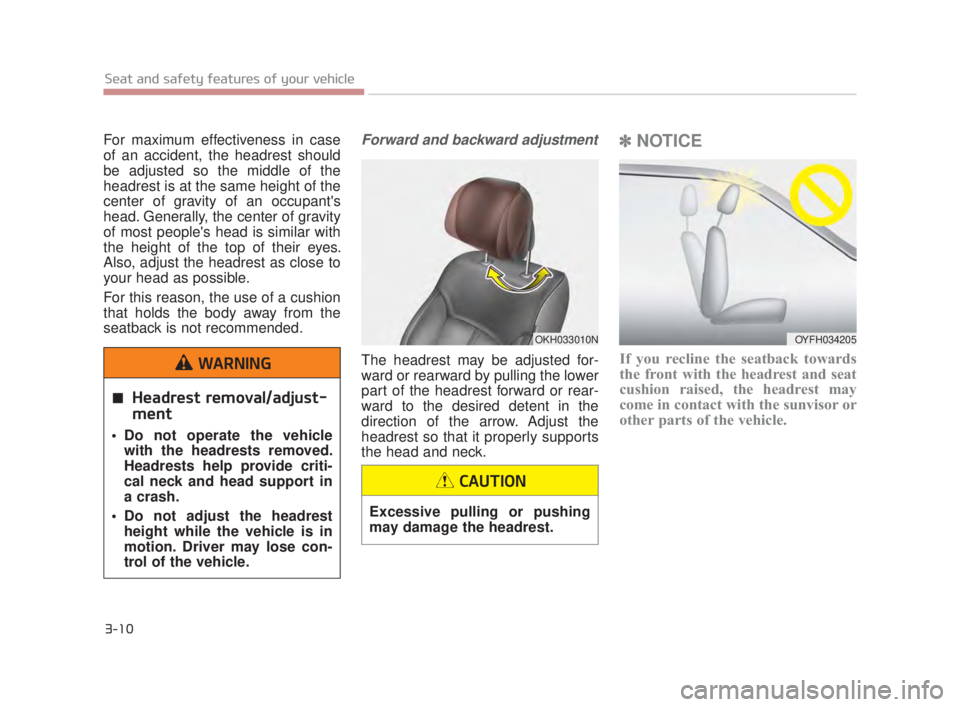
3-10
Seat and safety features of your vehicle
For maximum effectiveness in case
of an accident, the headrest should
be adjusted so the middle of the
headrest is at the same height of the
center of gravity of an occupant's
head. Generally, the center of gravity
of most people's head is similar with
the height of the top of their eyes.
Also, adjust the headrest as close to
your head as possible.
For this reason, the use of a cushion
that holds the body away from the
seatback is not recommended.Forward and backward adjustment
The headrest may be adjusted for-
ward or rearward by pulling the lower
part of the headrest forward or rear-
ward to the desired detent in the
direction of the arrow. Adjust the
headrest so that it properly supports
the head and neck.
✽NOTICE
If you recline the seatback towards
the front with the headrest and seat
cushion raised, the headrest may
come in contact with the sunvisor or
other parts of the vehicle.
OKH033010N
Headrest removal/adjust-
ment
Do not operate the vehicle
with the headrests removed.
Headrests help provide criti-
cal neck and head support in
a crash.
Do not adjust the headrest height while the vehicle is in
motion. Driver may lose con-
trol of the vehicle.
WARNING
OYFH034205
Excessive pulling or pushing
may damage the headrest.
CAUTION
KH USA 3:2018 4/18/2017 9:34 AM Page 10
Page 29 of 544
Seat and safety features of your vehicle
3
3-11
Adjusting the height up and down
For manual type
To raise the headrest
1.Pull it up to the desired position (1).
To lower the headrest
1.Push and hold the release button(2) on the headrest support.
2.Lower the headrest to the desired position (3). For power type
To raise the headrest
1. Push the control switch up (1).
To lower the headrest
2. Push the control switch down (2).
Release the switch once the head-
rest reaches the desired position.
Removal
1.Recline the seatback (2) with the
recliner control switch (1).
OKH033011N
OKH033095NOKH033008N
Headrest Removal
NEVER allow anyone to ride in a
seat with the headrest removed.
Headrests can provide critical
neck and head support in a
crash.
WARNING
KH USA 3:2018 4/18/2017 9:34 AM Page 11
Page 30 of 544
3-12
Seat and safety features of your vehicle
For manual type
2.Raise it as far as it can go.
3.Press the release button (3) whilepulling upward (4). For power type
1.Raise it as far as it can go by
pulling the switch up (3).
2.Pull the headrest up (4).
Installation
1.Recline the seatback (2) with the recliner control switch (1).
OKH033096NOKH033098N
OKH033100N
Headrest Reinstallation
To reduce the risk of injury to
the head or neck, always make
sure the head rest is locked into
position and adjusted properly
after reinstalling.
WARNING
KH USA 3:2018 4/18/2017 9:34 AM Page 12
Page 32 of 544
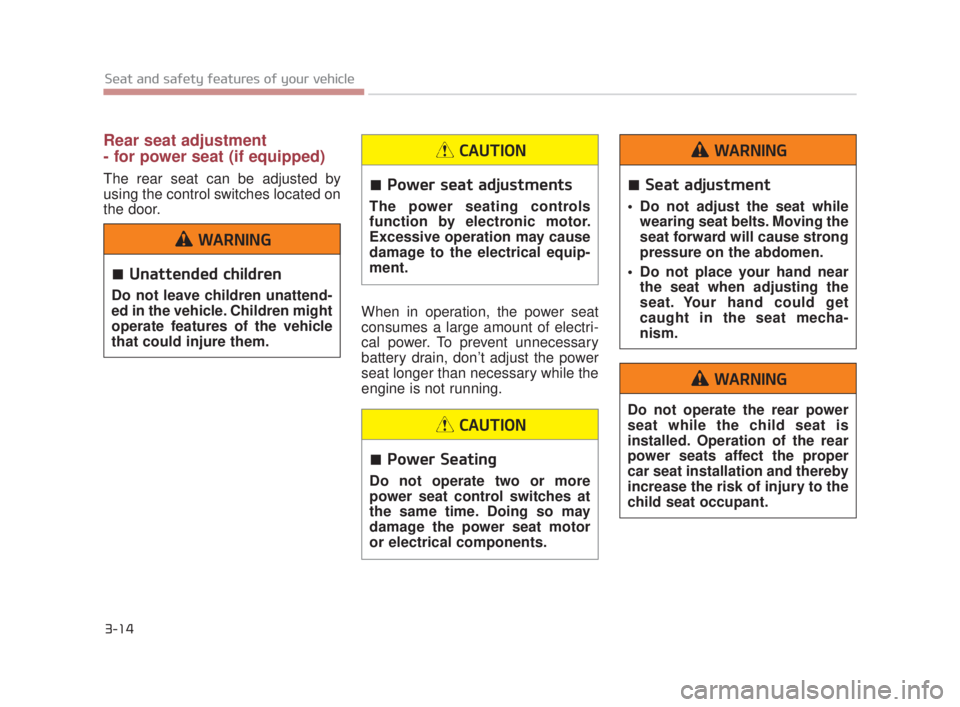
3-14
Seat and safety features of your vehicle
Rear seat adjustment
- for power seat (if equipped)
The rear seat can be adjusted by
using the control switches located on
the door.When in operation, the power seat
consumes a large amount of electri-
cal power. To prevent unnecessary
battery drain, don’t adjust the power
seat longer than necessary while the
engine is not running.Seat adjustment
Do not adjust the seat whilewearing seat belts. Moving the
seat forward will cause strong
pressure on the abdomen.
Do not place your hand near the seat when adjusting the
seat. Your hand could get
caught in the seat mecha-
nism.
WARNING
Do not operate the rear power
seat while the child seat is
installed. Operation of the rear
power seats affect the proper
car seat installation and thereby
increase the risk of injury to the
child seat occupant.
WARNING
Power seat adjustments
The power seating controls
function by electronic motor.
Excessive operation may cause
damage to the electrical equip-
ment.
CAUTION
Power Seating
Do not operate two or more
power seat control switches at
the same time. Doing so may
damage the power seat motor
or electrical components.
CAUTION
Unattended children
Do not leave children unattend-
ed in the vehicle. Children might
operate features of the vehicle
that could injure them.
WARNING
KH USA 3:2018 4/18/2017 9:34 AM Page 14
Page 36 of 544
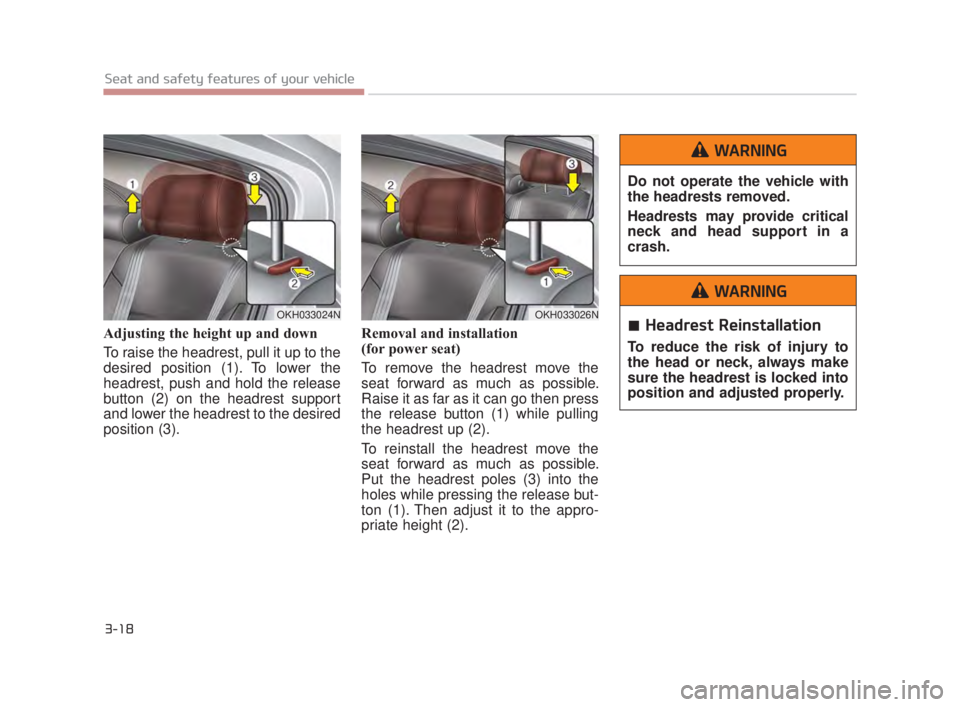
3-18
Seat and safety features of your vehicle
Adjusting the height up and down
To raise the headrest, pull it up to the
desired position (1). To lower the
headrest, push and hold the release
button (2) on the headrest support
and lower the headrest to the desired
position (3).Removal and installation
(for power seat)
To remove the headrest move the
seat forward as much as possible.
Raise it as far as it can go then press
the release button (1) while pulling
the headrest up (2).
To reinstall the headrest move the
seat forward as much as possible.
Put the headrest poles (3) into the
holes while pressing the release but-
ton (1). Then adjust it to the appro-
priate height (2).
OKH033026NOKH033024N
Do not operate the vehicle with
the headrests removed.
Headrests may provide critical
neck and head support in a
crash.
WARNING
Headrest Reinstallation
To reduce the risk of injury to
the head or neck, always make
sure the headrest is locked into
position and adjusted properly.
WARNING
KH USA 3:2018 4/18/2017 9:34 AM Page 18
Page 38 of 544
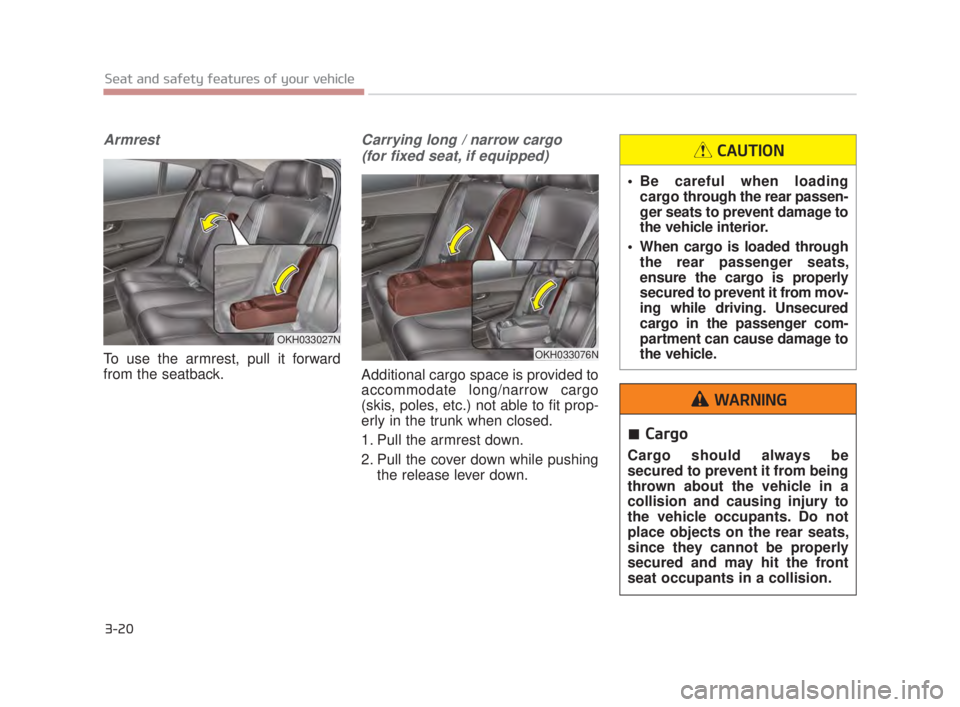
3-20
Seat and safety features of your vehicle
Armrest
To use the armrest, pull it forward
from the seatback.
Carrying long / narrow cargo (for fixed seat, if equipped)
Additional cargo space is provided to
accommodate long/narrow cargo
(skis, poles, etc.) not able to fit prop-
erly in the trunk when closed.
1. Pull the armrest down.
2. Pull the cover down while pushing the release lever down.
OKH033076N
OKH033027N
Be careful when loadingcargo through the rear passen-
ger seats to prevent damage to
the vehicle interior.
When cargo is loaded through the rear passenger seats,
ensure the cargo is properly
secured to prevent it from mov-
ing while driving. Unsecured
cargo in the passenger com-
partment can cause damage to
the vehicle.
CAUTION
Cargo
Cargo should always be
secured to prevent it from being
thrown about the vehicle in a
collision and causing injury to
the vehicle occupants. Do not
place objects on the rear seats,
since they cannot be properly
secured and may hit the front
seat occupants in a collision.
WARNING
KH USA 3:2018 4/18/2017 9:34 AM Page 20
Page 39 of 544
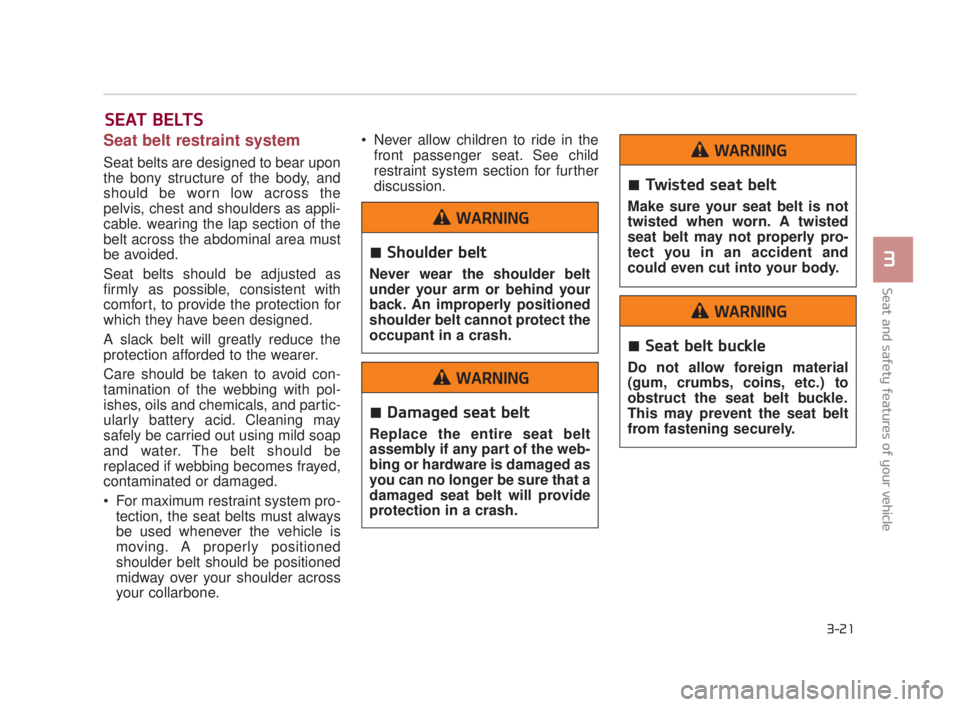
Seat and safety features of your vehicle
3
3-21
Seat belt restraint system
Seat belts are designed to bear upon
the bony structure of the body, and
should be worn low across the
pelvis, chest and shoulders as appli-
cable. wearing the lap section of the
belt across the abdominal area must
be avoided.
Seat belts should be adjusted as
firmly as possible, consistent with
comfort, to provide the protection for
which they have been designed.
A slack belt will greatly reduce the
protection afforded to the wearer.
Care should be taken to avoid con-
tamination of the webbing with pol-
ishes, oils and chemicals, and partic-
ularly battery acid. Cleaning may
safely be carried out using mild soap
and water. The belt should be
replaced if webbing becomes frayed,
contaminated or damaged.
For maximum restraint system pro-tection, the seat belts must always
be used whenever the vehicle is
moving. A properly positioned
shoulder belt should be positioned
midway over your shoulder across
your collarbone. Never allow children to ride in the
front passenger seat. See child
restraint system section for further
discussion.
SEAT BELTS
Shoulder belt
Never wear the shoulder belt
under your arm or behind your
back. An improperly positioned
shoulder belt cannot protect the
occupant in a crash.
WARNING
Damaged seat belt
Replace the entire seat belt
assembly if any part of the web-
bing or hardware is damaged as
you can no longer be sure that a
damaged seat belt will provide
protection in a crash.
WARNING
Twisted seat belt
Make sure your seat belt is not
twisted when worn. A twisted
seat belt may not properly pro-
tect you in an accident and
could even cut into your body.
WARNING
Seat belt buckle
Do not allow foreign material
(gum, crumbs, coins, etc.) to
obstruct the seat belt buckle.
This may prevent the seat belt
from fastening securely.
WARNING
KH USA 3:2018 4/18/2017 9:34 AM Page 21
Page 40 of 544

3-22
Seat and safety features of your vehicle
Seat belt warning (for driver’s seat)
The driver's seat belt warning light
and chime will activate to the follow-
ing table when the Engine Start/Stop
button is in "ON" position. The driver seat belt warning light and
chime will activate during following
situations.
The warning light and chime will
activate for 6 seconds when the
seat belt is not buckled and the
Engine Start/Stop button is in ON.
The warning light will activate for 6 seconds when the seat belt is
buckled and the Engine Start/Stop
button is in ON.
If the driver seat belt is buckled and then unbuckled during driving
- If the vehicle speed is below 3mph (5 km/h), the warning light
will illuminate for 6 seconds.
- If the vehicle speed is between 3 mph (5 km/h) ~ 6 mph (10 km/h),
the warning light and sound will
activate for 6 seconds.
- If the vehicle speed is over 6 mph (10 km/h), the warning light and
sound will activate for 6 seconds.
And repeat 11 times with 24 sec-
onds of interval. If the driver seat belt has not been
buckled at all during driving
- If the vehicle speed is over 6 mph(10 km/h), the warning light and
sound will activate for 6 seconds.
And repeat 11 times with 24 sec-
onds of interval.
- If the vehicle speed is below 3 mph (5 km/h), the warning light
and sound will turn off within
6seconds.
- If the seat belt has been buckled during driving, the warning light
will turn off within 6 seconds. The
warning sound will deactivate
immediately.
WKH-001
KH USA 3:2018 4/18/2017 9:35 AM Page 22